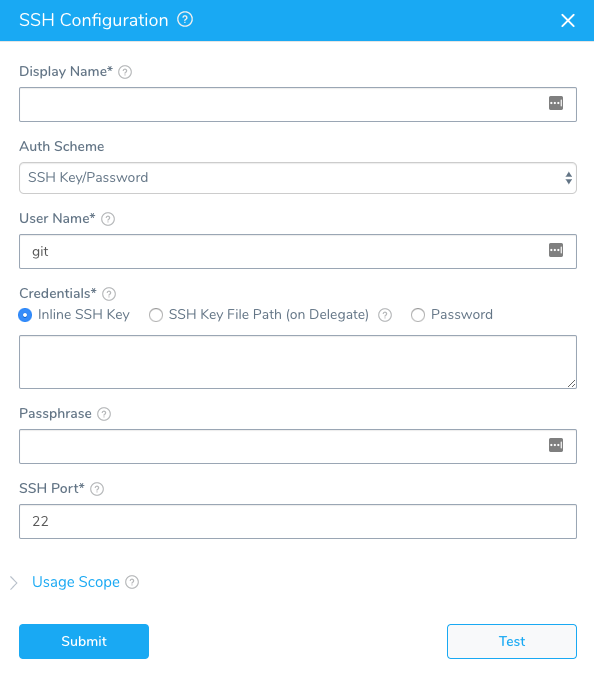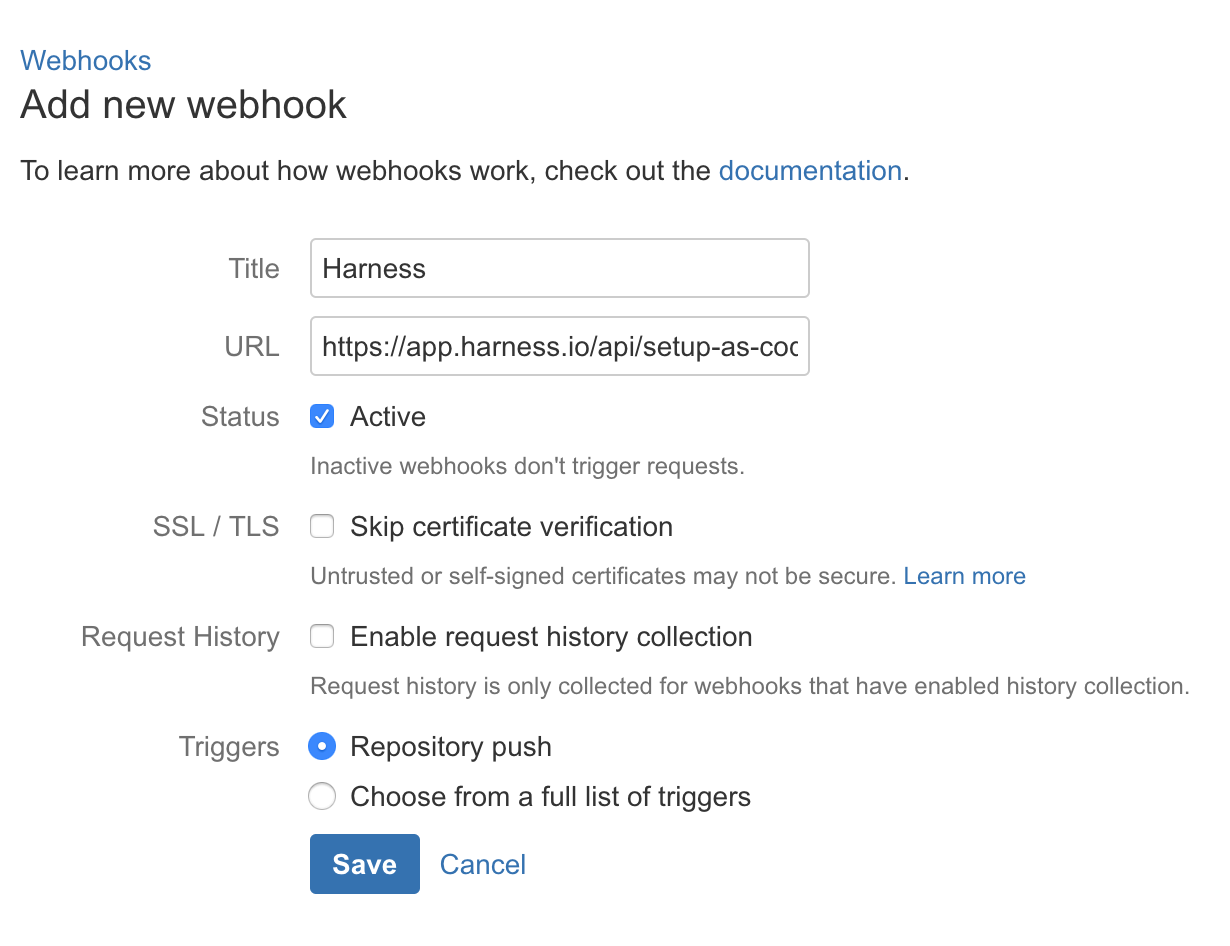Add a Bitbucket Repo
This topic outlines how to start syncing your Harness account and applications with one or more Bitbucket repositories. You add these repos as Source Repo Providers in Harness.
Before You Begin
Ensure your Git repo is initialized (git init) before connecting Harness to it.
Limitations
- One Harness Application cannot be in multiple repos.
- Before Harness syncs with your Git repo, it will confirm that all Harness' settings are in a valid state. If a connection is not working—for example, a connection to an Artifact Server or Cloud Provider—Harness will not sync with your Git repo.
Fetching very large repos
Currently, this feature is behind the feature flag OPTIMIZED_GIT_FETCH_FILES. Contact Harness Support to enable the feature.
Harness performs a git clone to fetch files. If the fetch is timing out, it can be because the repo is too large for the network connection to fetch it before timing out. To fetch very large repos, enable the feature flag OPTIMIZED_GIT_FETCH_FILES. When this feature flag is enabled, Harness will use provider-specific APIs to improve performance.
Some important notes:
- If you enable
OPTIMIZED_GIT_FETCH_FILES, you must use a token for authentication. Passwords are not supported. - If you enable
OPTIMIZED_GIT_FETCH_FILES, all of the files and folders must be in the same directory. You cannot fetch files outside of the repo or use symlinks.
Step: Add Source Repo Provider
To add a source repo, do the following:
- Click Setup.
- Click Connectors.
- Click Source Repo Providers, and then click Add Source Repo Provider. The Git Connector settings appear.
Step: Display Name
Enter a name for the repo connection. This is the name you will select when you sync your Harness account and applications in Configuration as Code.You could create a Source Repo Provider for the Harness admin account, such as Admin_Bitbucket. Later, you can create a Source Repo account for each Harness user, such as J_User_Bitbucket.
Step: Provider
Currently, this feature is behind the Feature Flag OPTIMIZED_GIT_FETCH_FILES. Contact Harness Support to enable the feature.
In Provider, select Git.
Step: Git Repo or Git Account
You can add a connection to your entire Git account or just a repo in the account. Selecting a Git account enables you to use one Source Repo Connector for all of your subordinate repos.
Later when you test this connection, you will use a repo in the account.
In either case, when you use the Connector later in Harness, you will specify which repo to use.
Step: HTTPS/SSH
Select HTTPS or SSH for the connection. You will need to provide the protocol-relevant URL in URL. If you use Two-Factor Authentication for your Git repo, connect over HTTPS or SSH.
For SSH, ensure that the key is not OpenSSH, but rather RSA or another algorithm. To generate an SSHv2 key, use:
ssh-keygen -t rsa -m PEM
The rsa and -m PEM ensure that the key is RSA.
Next, follow the prompts to create the PEM key. For more information, see the ssh-keygen man page.
If you log into Bitbucket using a Google account, you can create an application password in Bitbucket to use with Harness. For steps on this, see App passwords from Atlassian.
Step: URL
Enter the URL for your Git repo. Ensure that it matches the option you selected in HTTPS/SSH.
If you selected Git Repo in Type, enter the full URL for the repo.
For HTTP, the format for the URL should be https://bitbucket.org/<userName>/<repoName>.git.
If you selected Git Account in Type, enter the URL without the repo name. When you use this Source Repo Provider in a Harness setting you will be prompted to provide a repo name.
Step: Username and Password/Token
In Select Encrypted Password/Token, select or create a new Harness Encrypted Text secret for the credentials of your BitBucket user account.
If you have set up Two-Factor Authentication in your Git repo, then you need to generate a personal access token in your repo and enter that token in the Password/Token field.
If you enable OPTIMIZED_GIT_FETCH_FILES, you must use a token for authentication. Passwords are not supported.
Step: SSH Key
If you selected SSH as the connection protocol, you must add the SSH Key for use with the connection. If you added a key in Harness Secrets Management, you can select it here. For more information, see Secrets Management. To add a new key, click the drop-down and select Add New SSH Key. The SSH Configuration dialog appears.

In User Name, enter git. Ensure that it is lowercase.
git is the only value you should use in User Name.In Credentials, paste in the key or key file path, enter a display name, and then click Submit.
Step: Branch Name
If you selected Git Repo in Type, enter the branch name to sync with Harness, such as master, dev, or myAppName. Do not enter the full URL to the branch.
Names may not contain characters from the Emoticons unicode block.
Option: Delegate Selector
If you want this Connector to use one or more specific Delegates, use a Delegate Selector. If you do not use a Selector, Harness will select a Delegate that has worked in the past for this type of Connector.
In Delegate Selector, select the Selector for the Delegate(s) you want this Connector to use. You add Selectors to Delegates to make sure that they're used to execute the command. For more information, see Select Delegates with Selectors.
Harness will use Delegates matching the Selectors you add.
If you use one Selector, Harness will use any Delegate that has that Selector.
If you select two Selectors, a Delegate must have both Selectors to be selected. That Delegate might also have other Selectors, but it must have the two you selected.
Step: Generate Webhook URL
Enable this checkbox if you want to sync Harness with your repo bidirectionally. Changes made on either end will be synced. If you simply want Harness changes synched unidirectionally with the repo, disable this checkbox. When you use this Source Repo Provider to sync a Harness application to a repo bidirectionally, any account or application that uses this Source Repo provider will be synced bidirectionally. For more information, see Configuration as Code.
Step: Customize Commit Attributes (Git Sync Only)
When Harness commits or pushes a change to Git as part of syncing, it uses Harness.io and support@harness.io as the author and commit email address of that commit.
In some cases, you might have strong pre-commit limitations on who may or may not commit. In that case, you need to provide an author name and email that is approved to push on that repo. You can add an Author Name and Author Email address that will be applied whenever Harness syncs with the Git repo.
Option: Using the Webhook
If you selected the Generate Webhook URL option when adding your Source Repo Provider, the Generated Webhook URL dialog appears. Copy the URL and use it in your repo to enable your repo to sync changes to Harness.
Use the Repository push event trigger.
 For information on Bitbucket Webhooks, see Manage webhooks from Bitbucket.
For information on Bitbucket Webhooks, see Manage webhooks from Bitbucket.
Bitbucket Post Webhooks Plugin
Webhooks do not work with older versions of Bitbucket. You need to install the Post Webhooks for Bitbucket plugin in Bitbucket to enable Harness to allow two-way sync with Bitbucket.
If you are using a locally-hosted Bitbucket server and a different Webhooks plugin, the push event payload sent to Harness is different than the Post Webhooks for Bitbucket plugin, and this payload can cause issues. Ensure that you install the Post Webhooks for Bitbucket plugin. The Post Webhooks for Bitbucket plugin will send the push event payload in a format Harness can use.
Step: Test and Save
To finish configuring this Source Repo Provider:
- In the Git Connector settings, click Test. If you selected Git Account in Type, you need to provide a subordinate repo to test with.
Harness verifies the settings you entered. - When testing is successful, click Submit. This Source Repo Provider is now added to Harness.
Next Steps
- Once a Source Repo Provider is set up, you can use it—at the Harness account level and Application level—to sync your account and/or applications with your Git repo. See Configuration as Code.
- To trigger Harness workflows and pipelines using Git Webhooks, see Add a Trigger.
- To sync and clone a Harness Application template in Git, see Onboard Teams Using GitOps.